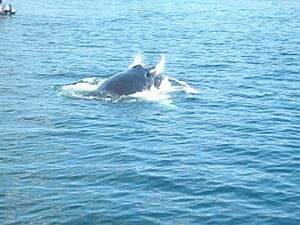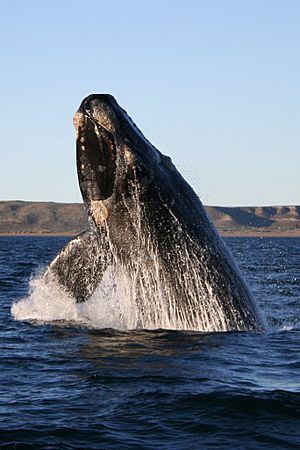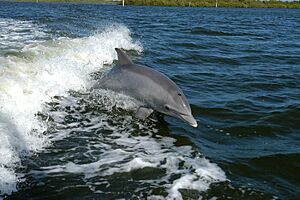Whale watching in Sydney facts for kids
Whale watching is a super fun activity in Sydney, especially during winter and spring! Many different types of whales travel past Sydney at different times of the year. It's an amazing chance to see these giant ocean creatures up close.
Contents
Humpback Whale Journeys
Every year, humpback whales travel past Sydney between April and December. This journey is called a migration. The migration is split into two main parts, depending on which way the whales are swimming.
These whales are part of a group called the Group 5 Southern Hemisphere humpback whale population. You might also hear them called the Australian East Coast humpbacks. They are different from other humpback groups that swim along the west coast of Australia or near South Africa.
Whales often swim closer or further from the coast based on ocean currents. The East Australian Current (EAC) is a strong current that flows south. Humpback whales use this current to help them swim south. When they swim north, they often use the Inshore Northern current. This current flows north, going against the EAC. The main reason humpback whales make this long trip every year is to breed and have their babies.
If you want to watch whales from the shore, the best places are high spots. Look for cliffs and headlands along the coast.
Some of the best places to spot whales from south to north are:
- Cape Solander, Kurnell, Botany Bay National Park
- Cape Banks, La Perouse
- Magic Point, Maroubra
- Ben Buckler, Bondi
- South Head Signal Station, South Head
- North Head Lookout, North Head National Park
- Long Reef Point
It's also possible to see whales from beaches, but it's not as common.
You can also join commercial whale watching tours. These tours run daily during the humpback seasons. You can board these boats at Darling Harbour, Circular Quay, and other docks around Sydney Harbour.
Northern Journey: Heading North to Reproduce
From April to mid-August, humpback whales swim north. They are heading to the warmer waters of the Coral Sea to give birth and mate. During this time, they usually swim steadily north at about 5 to 9 kilometers per hour. They also come to the surface regularly to breathe.
The whales use the Inshore Northern current to help them on their way north. This current is usually found within about 5.5 kilometers of the coast. So, most of the whales will swim close to shore. This makes it easier for people watching from the land to see many humpback whales passing by Sydney.
Sometimes, especially when the currents are strong near the shore, a group of humpback whales might enter Sydney Harbour for a short time. They usually leave within a few hours. They rarely go far inside the harbour.
Typical Behaviors on the Northern Journey
Whales show many cool behaviors as they travel:
- Breaching: This is when a whale jumps almost completely out of the water!
- Tail slapping: Whales hit their tails on the water, making a loud splash.
- Lunging: A powerful forward movement, often when feeding or playing.
Southern Journey: Heading South to Feed
From mid-August to mid-December, humpback whales swim south. They are returning to their feeding grounds in the Antarctic for the southern hemisphere summer. While they generally head south, they might swim in any direction for hours. They also come to the surface less consistently.
On this southern journey, they usually swim slower than when they go north. They use the East Australian Current (EAC) to help them move south. The EAC usually starts about 5.5 kilometers from the coast. It can be strongest up to 37 kilometers from the coast. This means it can sometimes be harder to spot the southern humpback migration from the shore.
However, from early October to mid-December, mothers and their newborn calves pass south. These pairs tend to swim very close to the shoreline. They often stop in calm, protected areas near beaches to rest and feed.
Typical Behaviors on the Southern Journey
You might see these behaviors from whales heading south:
- Breaching: Jumping out of the water.
- Tail slapping: Hitting the water with their tails.
- Spyhops: A whale lifts its head straight out of the water, like it's looking around.
- Mugging: This is when whales come very close to boats to check them out.
- Feeding: Mothers and calves might be seen feeding, especially when resting.
Southern Right Whale Season
The southern right whale does not travel in the same way as humpback whales. During the winter months, southern right whales move along the coastline. They look for safe places to mate and shelter with their newborn calves.
They will enter and stay in bays and harbours for days at a time. Then they slowly move north or south. While they are not as common as humpback whales, they are often easier to see. This is because they are more visible and do not move away as quickly. In the past, they have even swum as far as the Harbour Bridge in Sydney Harbour. They have also been seen in Botany Bay. Sometimes, they rest just a few meters from the shore of popular surf beaches!
Other Whales You Might See
You might also see other types of whales passing the Sydney coast at different times. These include Minke whales, Bryde's whales, false killer whales, killer whales, and pilot whales. Very rarely, you might even spot blue, fin, and sei whales. Sperm whales live off the coast of Sydney, but they usually stay far out at sea. They prefer the edge of the continental shelf, more than 37 kilometers from shore. So, you won't often see them close to land.
Dolphins
Groups of common dolphins and bottlenose dolphins are very common along the Sydney coastline. They are present all year round. You can easily see them from the coast, playing and swimming in the waves.
Volunteer Whale Stations
During the humpback whale migration, there are two special stations. Volunteers staff these stations to research and observe whales. This is part of a partnership between Macquarie University and a whale watching company.
One volunteer station is at Cape Solander. It operates from late May to early August for the annual northern migration whale survey. The other station is at North Head. It runs from late May to the end of August. Volunteers there are research spotters, helping to understand how whales interact with boats.




